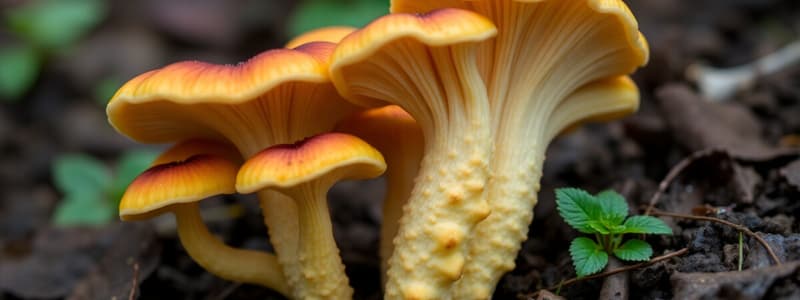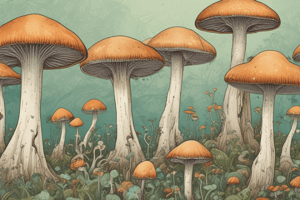Podcast
Questions and Answers
What type of nutrition do fungi primarily use?
What type of nutrition do fungi primarily use?
- Symbiotic nutrition
- Absorptive nutrition (correct)
- Chemosynthetic nutrition
- Photosynthetic nutrition
Which statement about fungi and their evolution is correct?
Which statement about fungi and their evolution is correct?
- Fungi evolved from prokaryotic organisms
- Fungi and animals share a common evolutionary ancestor (correct)
- Fungi independently evolved from plants
- Fungi are closely related to plants
Which of the following is a characteristic feature of fungi?
Which of the following is a characteristic feature of fungi?
- They are always unicellular
- They are motile organisms
- They possess cell walls made of chitin (correct)
- They have chloroplasts for photosynthesis
Which of the following describes the movement of fungi?
Which of the following describes the movement of fungi?
What type of relationship do mycorrhizal fungi have with plant roots?
What type of relationship do mycorrhizal fungi have with plant roots?
What is the structure called that forms the root-like network of fungi?
What is the structure called that forms the root-like network of fungi?
Which of the following is NOT a characteristic of animals?
Which of the following is NOT a characteristic of animals?
What structure does the fungi provide in the relationship with algae or cyanobacteria in lichens?
What structure does the fungi provide in the relationship with algae or cyanobacteria in lichens?
Which of these features helps animals with directional movement?
Which of these features helps animals with directional movement?
During which period did significant animal diversification occur?
During which period did significant animal diversification occur?
What is the term for a mycelium that contains two different parent mycelia?
What is the term for a mycelium that contains two different parent mycelia?
What is the primary role of mycorrhizal fungi in relation to plants?
What is the primary role of mycorrhizal fungi in relation to plants?
Which feature distinguishes animals from fungi?
Which feature distinguishes animals from fungi?
What type of symmetry do sea anemones exhibit?
What type of symmetry do sea anemones exhibit?
What distinguishes triploblastic animals from diploblastic animals?
What distinguishes triploblastic animals from diploblastic animals?
Which term describes a body cavity that is not fully lined by mesoderm?
Which term describes a body cavity that is not fully lined by mesoderm?
In terms of reproductive strategies, what is characteristic of most animals?
In terms of reproductive strategies, what is characteristic of most animals?
What closely related organism is considered the closest living relative to animals?
What closely related organism is considered the closest living relative to animals?
What is the primary role of predator-prey relationships in ecosystems?
What is the primary role of predator-prey relationships in ecosystems?
Which organism or group is NOT an example of a diploblastic animal?
Which organism or group is NOT an example of a diploblastic animal?
What does the term 'gametic life cycle' refer to in animal reproduction?
What does the term 'gametic life cycle' refer to in animal reproduction?
What is a defining characteristic of protostomes compared to deuterostomes?
What is a defining characteristic of protostomes compared to deuterostomes?
Which germ layers do diploblastic animals possess?
Which germ layers do diploblastic animals possess?
What is the primary function of mycelium in fungi?
What is the primary function of mycelium in fungi?
What role do hyphae play in the structure of fungi?
What role do hyphae play in the structure of fungi?
During which stage does the fusion of the nuclei occur in the sexual reproduction of fungi?
During which stage does the fusion of the nuclei occur in the sexual reproduction of fungi?
Which statement about the reproduction of fungi is true?
Which statement about the reproduction of fungi is true?
How do fungi primarily absorb nutrients from their environment?
How do fungi primarily absorb nutrients from their environment?
What is the primary composition of the cell walls of fungi?
What is the primary composition of the cell walls of fungi?
Which phase follows plasmogamy in the sexual reproduction cycle of fungi?
Which phase follows plasmogamy in the sexual reproduction cycle of fungi?
What distinguishes multicellular fungi from single-celled yeasts?
What distinguishes multicellular fungi from single-celled yeasts?
What structure forms after the fusion of two different nuclei in a fungi's reproductive cycle?
What structure forms after the fusion of two different nuclei in a fungi's reproductive cycle?
How do fungi grow in terms of hyphal structure?
How do fungi grow in terms of hyphal structure?
Which category do fungi belong to due to their function in the ecosystem?
Which category do fungi belong to due to their function in the ecosystem?
What type of reproduction is NOT typically associated with fungi?
What type of reproduction is NOT typically associated with fungi?
What is the composition of spores produced by fungi during sexual reproduction?
What is the composition of spores produced by fungi during sexual reproduction?
What type of organism do fungi commonly share a common ancestor with?
What type of organism do fungi commonly share a common ancestor with?
Study Notes
Fungi
- Fungi are heterotrophic, meaning they cannot produce their own food.
- They use absorptive nutrition, absorbing nutrients from their environment.
- Most fungi are multicellular, but there are also single-celled yeasts.
- Fungi are sessile, meaning they cannot move.
- Fungi have cell walls made of chitin.
- Fungi are closely related to animals and both evolved multicellularity independently.
- Fungi reproduce both sexually and asexually.
- During asexual reproduction, fungal mycelium (haploid, n) produces spores that germinate to form new haploid mycelia.
- During sexual reproduction, plasmogamy (fusion of cytoplasm from two parent mycelia, both haploid, n) occurs, forming an interkaryotic stage with two different nuclei.
- This is followed by karyogamy, the fusion of the nuclei from the two parents, forming a diploid zygote (2n).
- The diploid zygote undergoes meiosis to produce haploid spores.
- These spores then germinate to form new haploid mycelia.
- The mycelium of fungi is made up of tiny filaments called hyphae.
- Hyphae are tubular cell walls surrounding a membrane and cytoplasm.
- The hyphae are interwoven to form mycelium which infiltrates food, maximizing the surface-to-volume ratio for efficient nutrient absorption.
- Fungi absorb nutrients from their environment by osmosis, where water moves into their cells.
- Fungi grow by lengthening their hyphae, not widening them.
- Fungi have spore-producing structures for sexual and asexual reproduction.
- Fungi are decomposers, breaking down and absorbing nutrients from non-living organic materials such as logs and animals.
- Mycorrhizal fungi form mutually beneficial relationships with plant roots, helping plants absorb water and nutrients, while the fungi get food produced by the plant.
- Some fungi are parasitic pathogens that cause diseases in plants and take their nutrients.
- Lichens are symbiotic relationships between fungi and algae or cyanobacteria.
- The fungi provides structure and protection, while the algae or cyanobacteria produce food.
Animals
- Animals are heterotrophic, multicellular, and process food internally.
- Animals do not have cell walls but have nerves and can move, usually.
- Many animals have bilateral symmetry, meaning their body parts are arranged in a mirror image along a central axis.
- Bilateral symmetry helps with directional movement.
- The Cambrian Period saw a significant increase in animal diversity due to the development of predator-prey relationships.
- Some animals have radial symmetry, meaning their body parts are arranged around a central axis.
- Animals with radial symmetry are mostly sessile.
- Diploblastic animals have two layers of cells: ectoderm and endoderm. The ectoderm forms the outer covering and the endoderm lines the digestive tract.
- Triploblastic animals have three layers of cells: ectoderm, mesoderm, and endoderm.
- The mesoderm forms muscles, bones, and other internal organs, leading to more complex animals.
- Animals typically reproduce sexually with a gametic life cycle where diploid cells dominate. The life cycle includes fertilization, meiosis, and mitosis.
- A pseudocoelom is a body cavity that is not fully lined by mesoderm. Nematodes are an example of animals with a pseudocoelom.
- The closest living relative to animals is the choanoflagellate.
- Animals are divided into protosomes and deuterostomes based on developmental differences.
Studying That Suits You
Use AI to generate personalized quizzes and flashcards to suit your learning preferences.
Related Documents
Description
Explore the fascinating world of fungi, including their unique characteristics and reproductive methods. This quiz covers the essential aspects of fungal biology, such as their multicellular nature, cell structure, and life cycle. Test your knowledge of how fungi reproduce both sexually and asexually.




